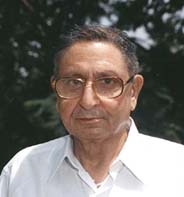|

|

|
|
Kashmiri Pandits' Association, Mumbai, India |

|
| | Home | August-September 2003 Issue | |
|
From the Pages of History
… J. N. Kachru Kashmir Under Mughals - II
First Visit: Accompanying his father, Jehangir visited Kashmir for the first time in 1589 AD. He seems to have fallen in love with the beauty of the Valley, its flora and fauna. In his memoirs 'Tuzk-i-Jehangiri', he eloquently describes its picturesque dales, its pleasant meadows, enchanting cascades, its verdure, its springs lakes and running water. Its multicoloured flowers and sweet scented herbs captivated his imaginations. Jehangir and his versatile queen Noor Jehan visited Kashmir several times. Their presence prevented any abuse of power by the governors. It also ensured justice and fair play. Gardens: The rule of Jehangir will always be remembered by his various gardens, still attraction of tourists. His governor Dilawar Khan laid many gardens. The name Bagh-e-Dilawar still exists. Jehangir himself got Shalimar laid, while Noor Jehan's brother Asaf Khan laid the Nishat garden. He planted Chinars systematically to create Char Chinari. Jehangir got an octagonal tank of sculptured stones made round the spring at Veerinag in 1620. Noor Jehan got a garden laid at Achabal. Administration: Jehangir's rule is known for his justice. He stopped the inhuman practice of Sati among Hindus and burying alive of Muslim widows. He made infanticide of girl child a crime. He also banned forcible conversions. He abolished levies like Rasum-i-Faujdari. Plague and Fire: It was during the governorship of Ahmed Beg in 1615 that an epidemic of plague broke out in a virulent form. There was no remedy then for the disease. In a few days, thousands of people died. About 12000 houses were destroyed in a devastating fire in Srinagar. The Jama Masjid which was reduced to ashes was rebuilt at state expense. Prosperity: The Valley flourished under Jehangir. The revenue rose to 74,670,000 dams. In 1622, Itqad Khan, a close relation of Noor Jehan was appointed as the governor. He indulged with impunity in tyrannical rule. He levied hard taxes on all commodities and particular communities. Farmers, orchardists and even boatmen were his special targets. He introduced Begar (forced labour). He tyrannised Shias. His misconduct and harsh treatment of the people marred Jehangir's otherwise golden rule. Jehangir died on 7 November 1627 at Behramgali, while on his way back from Kashmir. He was buried at Lahore. Shah Jehan: 1627-58 AD Jehangir was succeeded by his son Shah Jehan. The emperor took greater interest in Kashmir than his father. He visited Kashmir several times and like his father, was fascinated by its beauty. Itqad Khan continued as governor for six years under Shah Jehan. Taking undue advantage of his relation with Noor Jehan, he continued his misrule. Shah Jehan ultimately replaced Iqbal Khan by Zaffar Khan, a poet, a scholar and kind good administrator. On his recommendation, the emperor ordered abolition of all cruel taxes and relief to farmers, orchardists and boatmen. Zaffar Khan improved quality and taste of plum, peach and grapes by introducing better grafts and saplings from Iran and Afghanistan. He reduced Baltistan to vassalage, in spite of bad weather and difficult terrain. He suppressed Shia-Sunni rioting, deporting the leader of Sunnis to Agra. In 1638, when Shah Jehan was in Kashmir, a severe famine followed a devastating flood. The emperor cut short his visit and personally supervised despatch of grain from the Punjab. Zaffar Khan was replaced by prince Morad, the younger son of the Emperor. Given to a life of pleasure and luxury, Morad neglected his official duties. Taking undue advantage of their relation with the prince, the Maliks (whose daughter the prince had married) resorted to illegal exactions. On hearing about his misrule, the prince was removed only after one year. He was replaced by Ali Mardan Khan. He had come by a huge treasure as governor of Kandhar. Though an Iranian, he refused to give the money to the Shah of Iran. He came to India and was sent as governor to Kashmir, where he spent the money. He was tolerant and appointed Mahadev as his chief adviser. Ali Mardan Khan is credited with building Sarais on Mughal Road. Cheshma Shahi garden was laid during his governorship. Shah Jehan, the great Mughal builder, is known in Kashmir for building Cheshma Shahi pavilion, the upper portion of Shalimar with its pavilion, the scheme of fountains and Pari Mahal upon the spur of Zabarwan hill on the Dal Lake (also presumed to have been built by Dara Shikoh for his school of Suffism and an observatory). Shah jehan was dethroned and imprisoned by his son Aurangzeb in 1658. Aurangzeb: 1658-1707 AD The mighty empire founded by Babar and consolidated by Akbar, Jehangir and Shah Jehan witnessed the beginning of its end with the accession of Aurangzeb to the throne. Reason: Reversal of Akbar's policy or Aurangzeb's communal discrimination. Aurangzeb was a puritan and conservative in outlooks, otherwise he was honest and lived an austere life. Aurangzeb visited Kashmir only once in 1665. Considering the visit a share luxury, he never repeated it. 14 governors were sent to Kashmir during his regime. One Saif Khan (1664-67, 1668-71) built Safa Kadal. His adviser, Chaudhri Mahesh, laid out a garden on the slopes of the hill at Ishber. People were happy under certain subhedars. But there were certain exceptions. Iftikar Khan (1671-75) tyranised over the Brahmins, who approached Guru Tegh Bahadur, the ninth Guru at Anantpur for help. This ultimately led to Guru's martyrdom, and the conversion of Sikh community into a fighting Khalsa under his son, Guru Gobind Singh. Iftikar Khan was followed by equally cruel governors except Fazal Khan (1698-1701) who was liberal enough to give a peaceful time to the people. Aurangzeb died in 1707. Successors of Aurangzeb: 1707-1753. With the death of Aurangzeb, a series of wars of succession started. Fortunes of emperors and courtiers were changed rapidly. Governors appointed by various emperors were reluctant to move to Kashmir. They appointed their deputies. There is hardly any development to record. However, as in the rest of India, Kashmir witnessed the worst kind of intrigues, disorders and rebellions up to 1753. Tired of chaotic conditions, two prominent leaders of Kashmir Mir Muqim Kanth and Khwaja Zahir Dadmari took an impolitical step in inducing Ahmed Shah Abdali to invade Kashmir. Abdali sent a strong Afghan force under Abdullah Khan Ishk Aqasi. Afghans won the war after 15 days of bitter fight to bring the Mughal rule in Kashmir to an end. |
|
|
JOIN US |
|
|


 Jehangir succeeded his father, emperor Akbar in 1605
AD.
Jehangir succeeded his father, emperor Akbar in 1605
AD.

